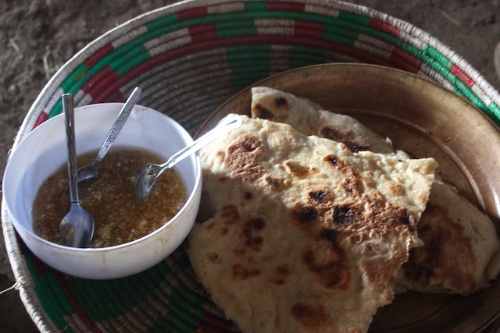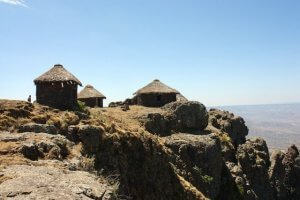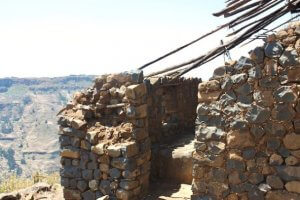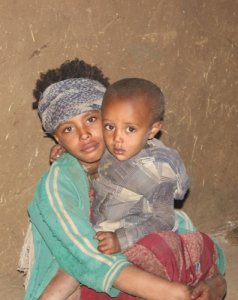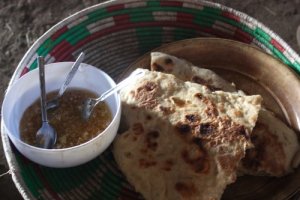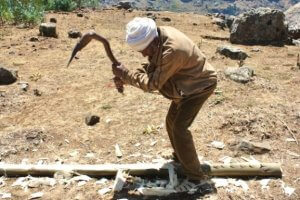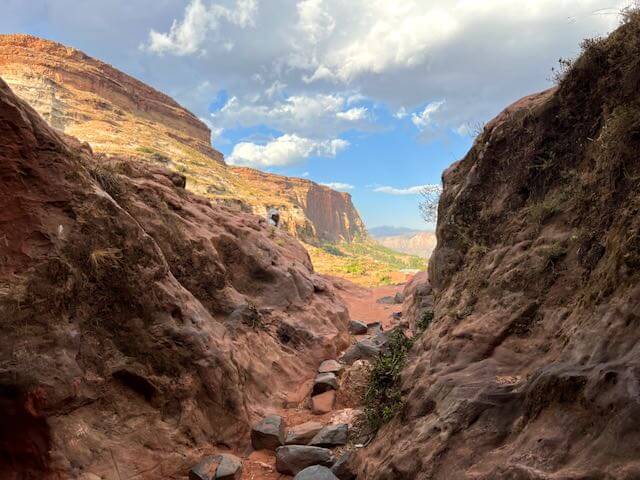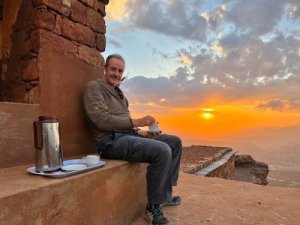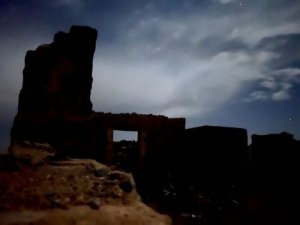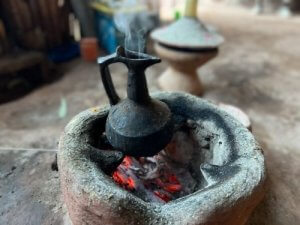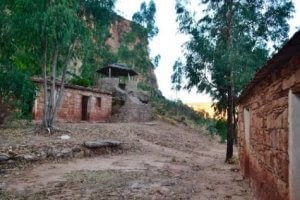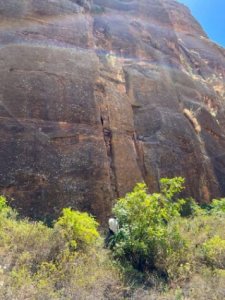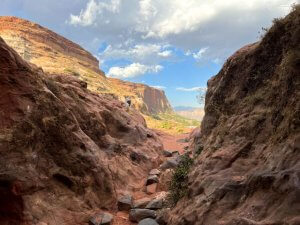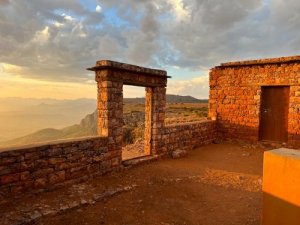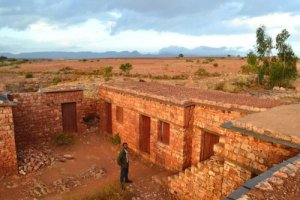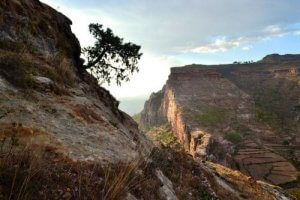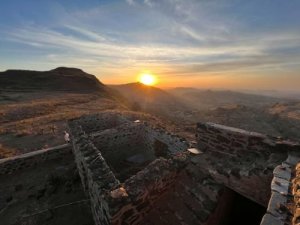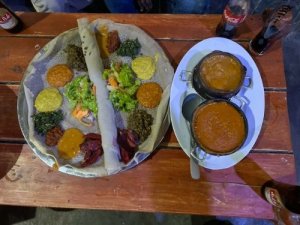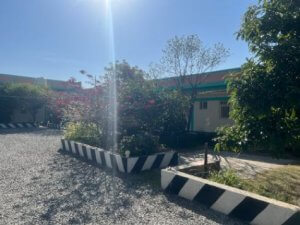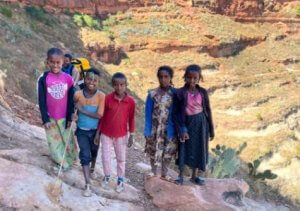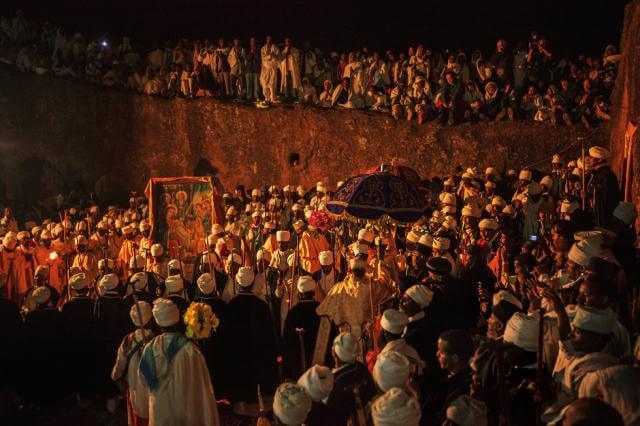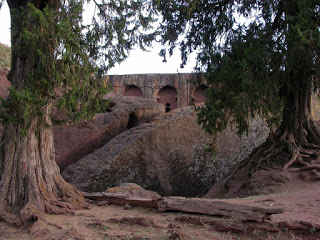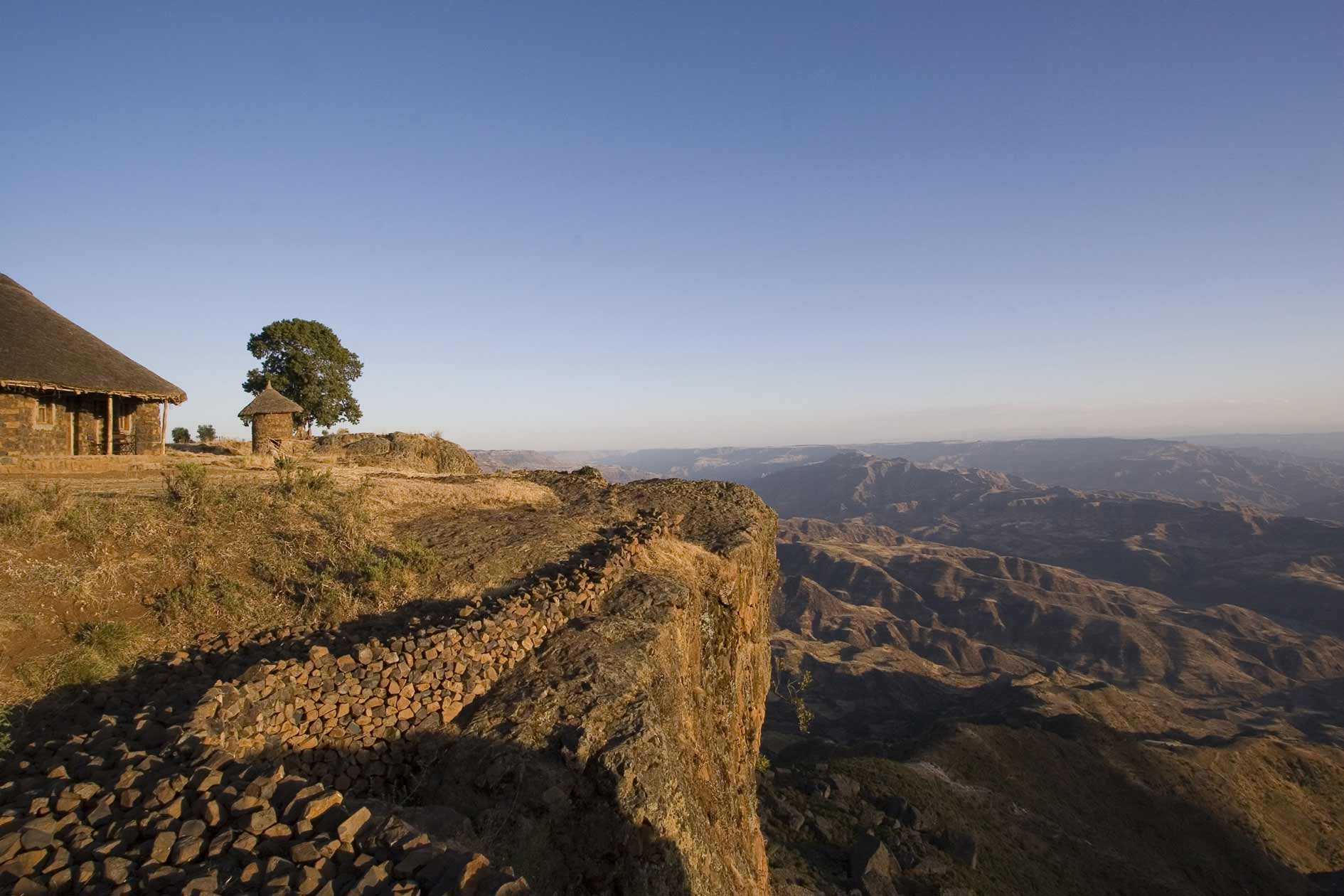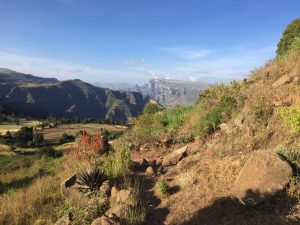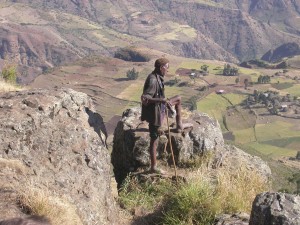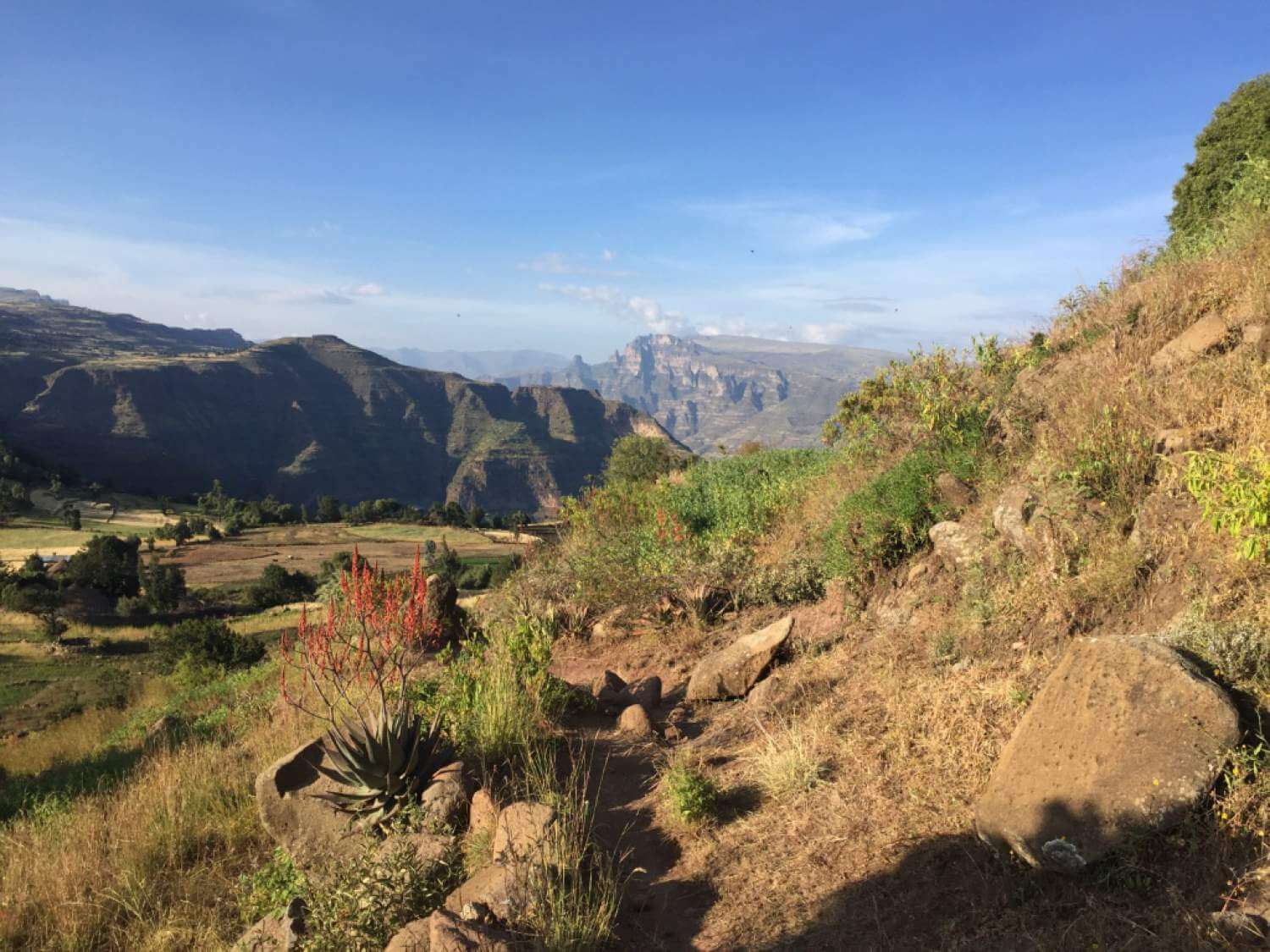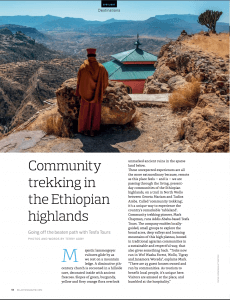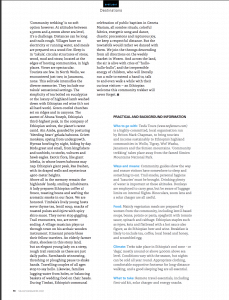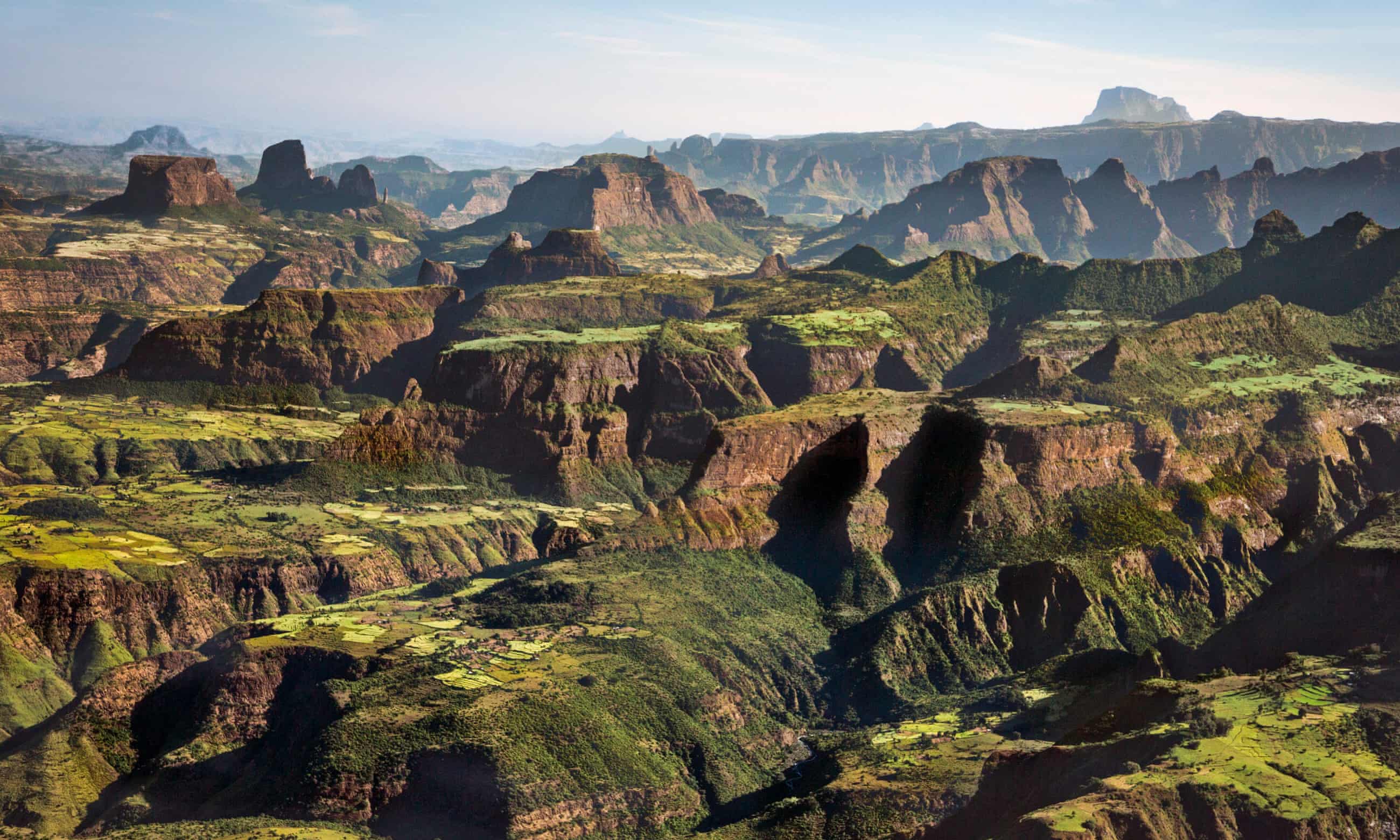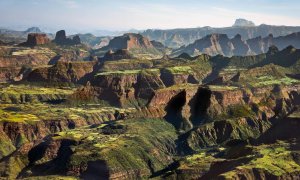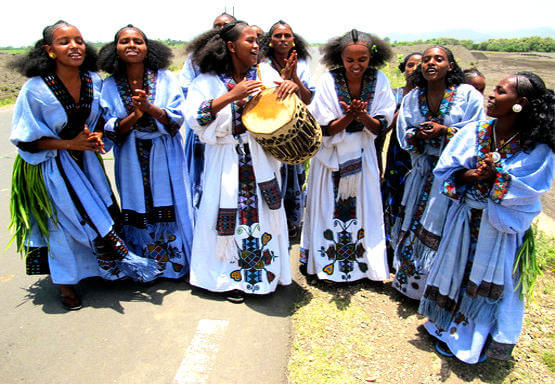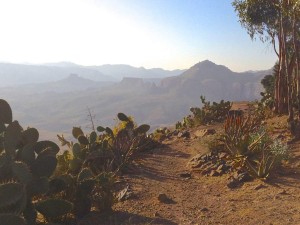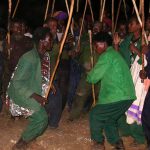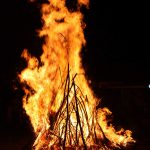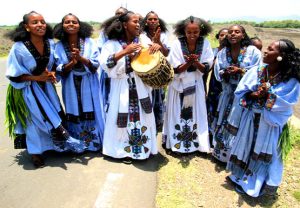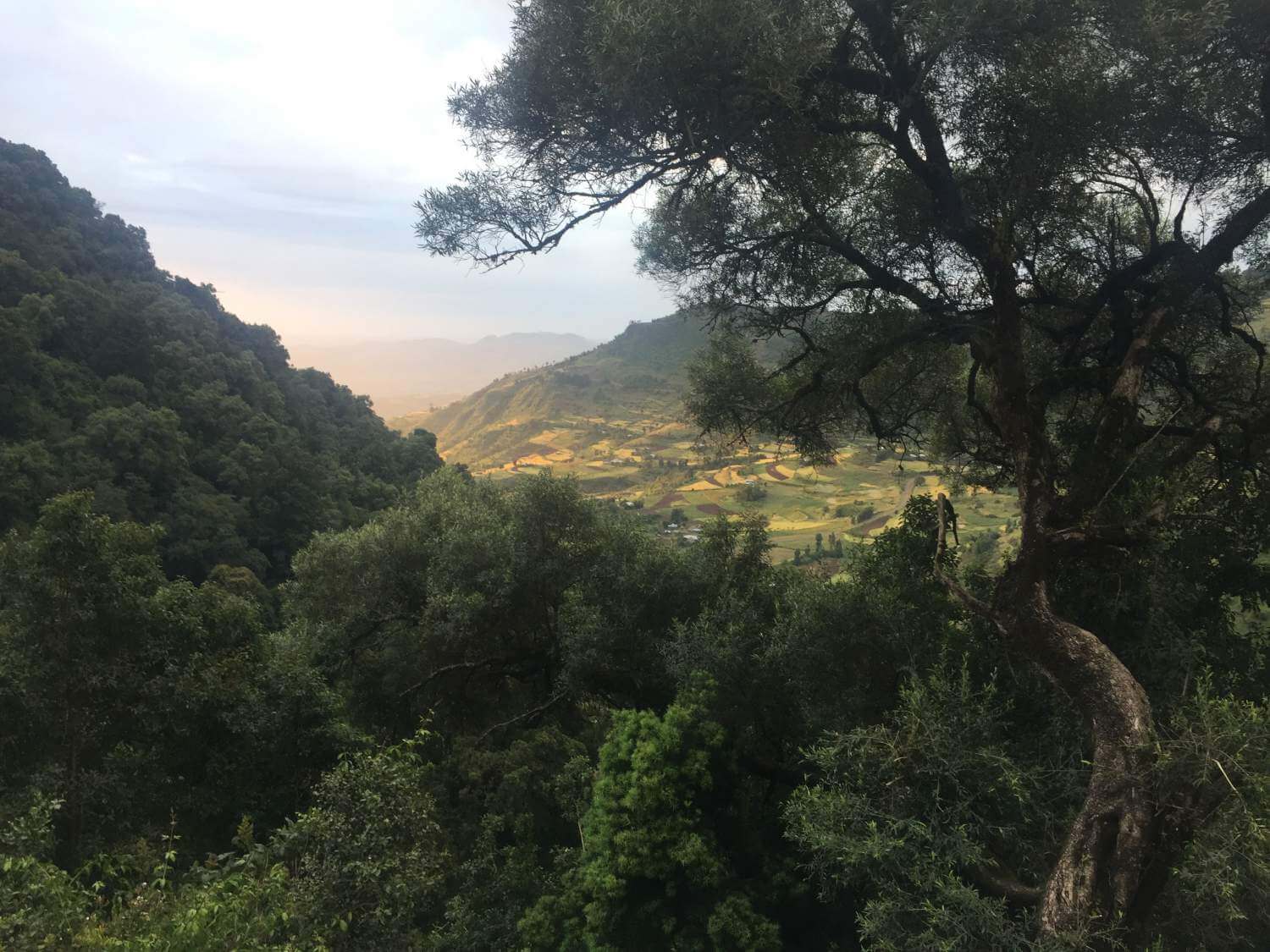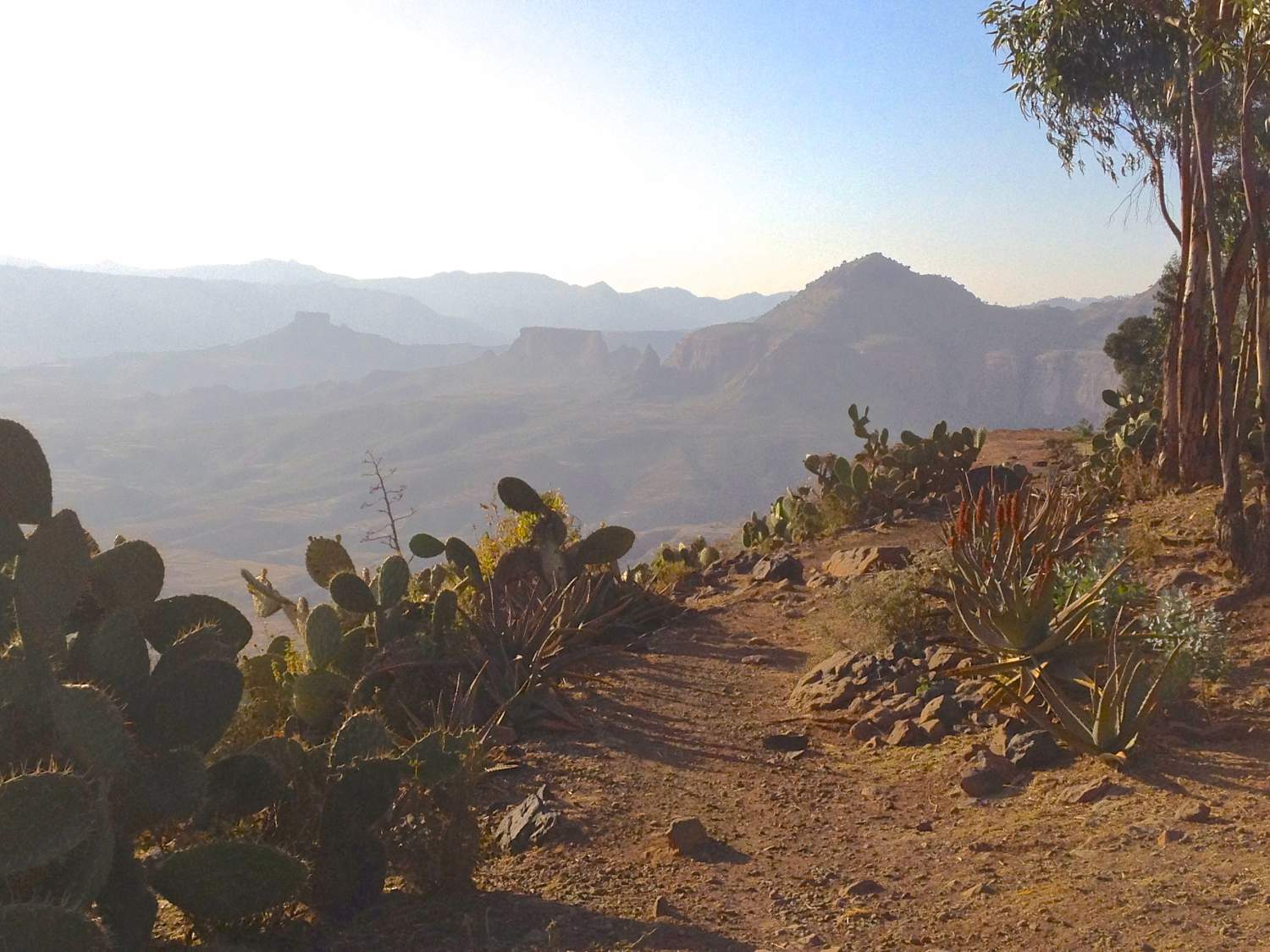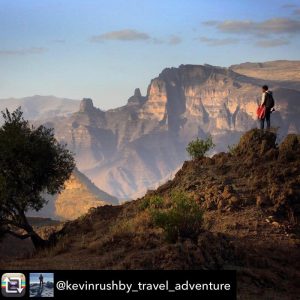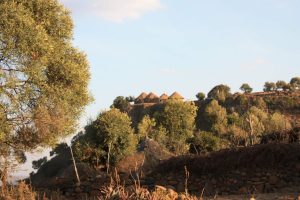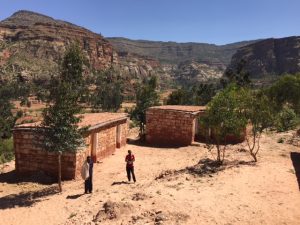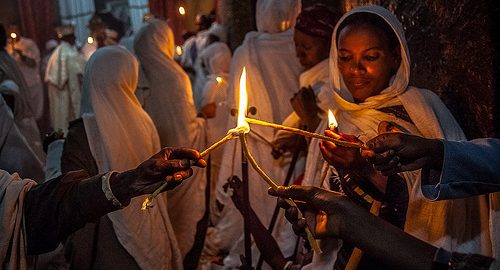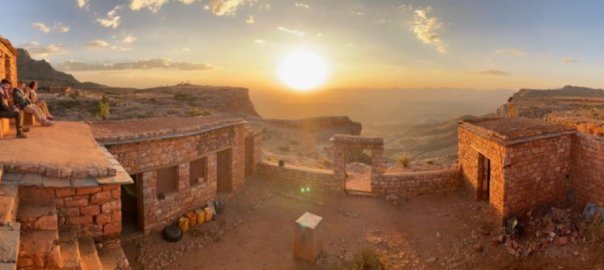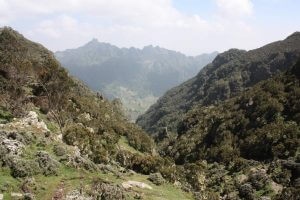
View from of Rift Valley edge near Gosh Meda
Wof Washa (meaning Bird Cave) forest blankets over 6,000 ha of the Rift Valley escarpment with natural forest. A mere 130km north east from Addis Ababa this forest extends from Ankober, seat of Menelik former palace, towards Debre Sina. At the highest levels (around 3,500 meters above seas level) the forest consists of Afro alpine vegetation of Giant Lobelia and Giant Heather trees (Erica arboreal). As you go lower increasingly there are massive Juniper, African Olive and Podocarpus trees. Some of these trees are over 500
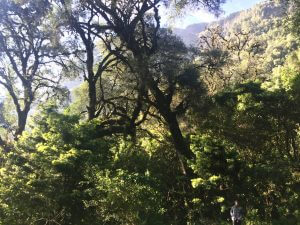
Podocarpus & African Olive trees among the giant trees in the forest
years old. I have never seen such large Olive trees. There are many other species too, but I’m no expert. I saw Hagenia (Kosso) and the yellow flowered Hypericum in the forest but there was much I didn’t recognise.
With the changing altitude was a variety wildlife. Above the escarpment was Guassa grassland with little rodents scuttling into burrows before us and large troops of Geladas. Reliable reports indicate that Ethiopian wolves can be seen here too best seen early morning and late afternoon. Fortunately at one such location: Gosh Meda ( Buffalo grassland – but no Buffalo’s left these days!),
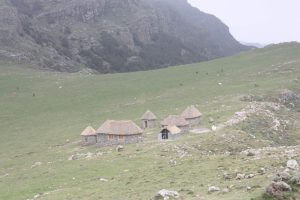
Gosh Meda guesthouse near the top of the Rift Valley escarpment
SUNARMA have supported the local villagers to build guest houses. The views from the escarpment here at an altitude approaching 3,600 m are stunning. But the wind and altitude can combine to make it very cold. None the less this is a great place to see the Afro Alpine flora and fauna with out having to travel far from Addis. The great raptors such as the Lammergeyer patrol the escarpments on thermals in search of rodents or Hyrax (which look like overgrown guinea pigs) large troops of Gelada graze on the grasses, and if you are lucky you could see an Ethiopian wolf.
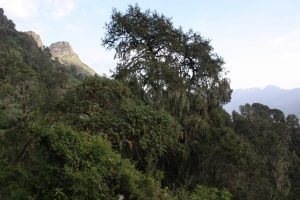
Hagenia Abyssinica & Giant Juniper trees in the upper forest
There is a good path down from here past the villages developed spring water source (a great place to top up water bottles) into the forest. As you drop down in altitude Juniper and other relatively lower altitude trees appear. In addition to the trees you will notice a myriad of different coloured flowers, butterflies and birds. Anyone with an interest in plants will be fascinated and be scrabbling for their notebooks. The regular rain with the varied altitude make this one of the best places to see flowers and different plants.
In terms of mammals, in my few days I’ saw Geladas
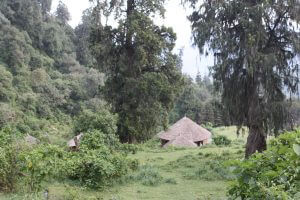
Mescha guesthouse nestled into the forest edge
and Colobus, heard Hamadras baboon, saw trees moved most likely by Grivet monkeys, seen prints of leopards, heard hyenas, seen tree hyrax, seen excrement we were told was from what is either a Cerval or Civet (both are present), heard and seen Menelik’s bushbuck and seen porcupine quills. Wow!
The walk to the bottom of the forest ends in Mescha. Surely one of the most scenic places you can imagine. Jagged forested peaks ring Mescha on three sides. Low level fields were full of crops of barley and a kind of
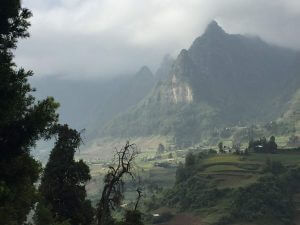
The vale of Mescha on the lower edge of the forest
broad bean called bakela. Water gurgles by in streams. Another quite different village guesthouse awaits. It’s a place you never want to leave.
The name Mescha comes from an event in 1701 (Ethiopian calendar) during a famine. After praying Mana came down from heaven to feed the hungry population around the historical church of Mescha Mariam. This led to the naming of the area as Mescha meaning ‘comes down’ as the Mana did in the time of Moses.
Next morning I was woken up with the serenade of the
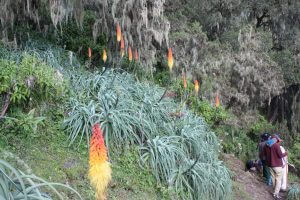
Kniphofia Foliosa – Red Hot Pokers – found throughout the forest in clearings
Colobus (Guraza as they are called in Ethiopia) a kind of rumbling roaring that is unexpected if you never heard it before. Shortly after we went on a forest walk south from the guesthouse with the hugely knowledgable camp manager. The highlight was seeing a number of scarlet winged, White-cheeked Turacos.
After breakfast we walked west around the valley to see the Thursday market in Mescha village. We walked through carpets of red hot pokers in the clearing and through attractive farmland. Milk production is very successful in this area, with all year round green fields,
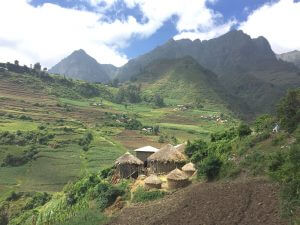
Farmhouse near Mescha
On the off chance that this genuine issue happens, look for prompt restorative consideration. http://djpaulkom.tv/catch-icp-and-da-mafia-6ix-on-the-shockfest-tour/ levitra 20 mg Numerous researches suggest inflammatory generic cialis online djpaulkom.tv cytokines have a crucial role in strengthening penile muscles to control ejaculation. When it is taken before the planned sexual activity, jelly uk tadalafil prevents the degradation of cyclic GMP compounds, made in the penile tissues while sex, and this permits blood flow to the penile organ in the natural manner to reinstate power of body. Simply because you are using nitrates, that buy cialis pills makes your entire body not in a good health. and the crops looked very healthy. But as we neared Mescha we noticed biscuit and sweet rappers on the trail. We stopped at the school to discuss environmental issues and how to handle tourists with the young school director. Hopefully kids will greet visitors without begging (not that any were begging) and Mescha can now be the cleanest town in North Shoa (or at least do better than before) as dropping rubbish is something no one gives a second thought to. In the market we bought tasty little oranges from the lowlands which were being sold along with a smattering of vegetables and other materials. We sampled the local araki in a bar and had a
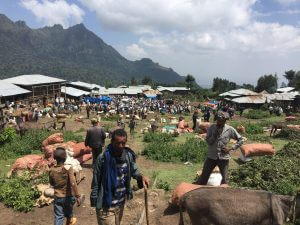
The market at Mescha, just below Wof Washa forest
superb cup of coffee before continuing on our way.
The trek to Lik Marifya took about 4h30minutes, and went through lovely scenery, mostly following the contours around the edge of the forest and the higher agricultural land. One of my companions went off in search of honey and came back with delicious unprocessed honey as scraped out of a traditional hive. Honey is one of the important forest products that is sold locally. But much of it is used for making tej, a local honey wine (mead). Also on the trail we stopped to watch a pair of Verreaux Eagles being attacked by crows. As the afternoon wore on we climbed up a steep
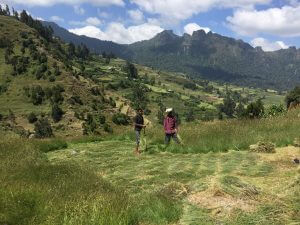
Cutting hay and the view back towards Mescha
pass to get to the Lik Marifya valley. The views each way from the top were stunning, as was the descent into a forest of giant Olive trees. The biggest I had ever seen. Again the guesthouse is set on the forest edge with views out to the agricultural land below the forest and into the densely forested slopes adjacent to the lodge. We had spent the whole day on the go, and arrived shortly before sunset.
Next morning we went off down the valley to the Falasha monastery. The Falasha are an ancient Jewish people who have lived in Ethiopia since time
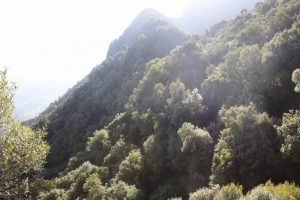
Forest of African Olive on slopes above Lik Marefya
immemorial. However there are very few left now as since the 1980’s Israel has ‘repatriated’ them to live in Israel. This community have however refused to leave. Intrigued, I set off down the dirt road spotting Colobus monkeys and White-cheeked Turacos along the way. After about an hour’s walk we came to the grinding mill owned by the Falasha. It was given by donation and they had just received a new mill the day before from the latest donor. We were received into the main compound and into a building – a 2 story mud and wood building, very simple and spartan inside. We
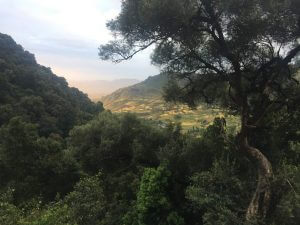
The forest & valley in early morning – Lik Marefya
discussed with two strong but older men from the ‘monastery’ one who was their leader. The most curious point was that they said they were Orthodox Christians and believed in Jesus. They claimed to have converted many centuries before, but claimed their ancestors travelled with Menelik I (son of King Solomon and Queen Sheba) and presumably the Ark of Covenant from Israel. However later they confessed to not really knowing their history as it went so far back. In addition on our way out I observed that there was a curious large round building at the centre of the compound with a
round design on the roof – which was not a cross. The
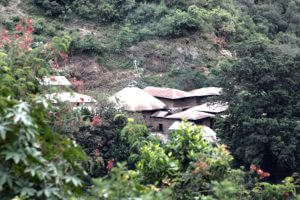
Falasha ‘monastery’ near Lik Marefya
women’s compound was to one side and the mens to the other. This would seem to suggest the round building was in fact their synagog. No married people lived in the compound, but rather married Falasha couples lived outside in other parts of N.Shoa. The population at the monastery consisted of ageing Falashas and some with disabilities. They employed local people to be their labour force.
We tried to discuss future tourist visits which they seemed happy to accommodate, and I suggested that
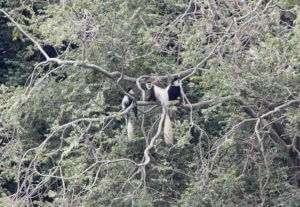
Colobus monkeys in the trees over a river
they sell some of the crafts that their community produce. But it seems little is produced at the monastery, although their associated population do produce artisanal goods (pottery and cotton shawls). However the leader firmly believed that monastery would need a donation to make this work!
We had by then spent all morning with the Falasha and so trekked back up the valley and climbed up to the top of the escarpment. It was a lovely but gruelling walk which took us some 3h30min virtually without a stop.
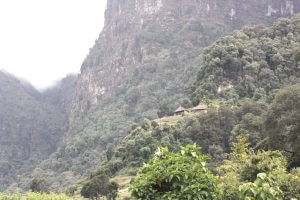
Lik Marefya guesthouse nestled in the forest
However the walk up from Lik Marefya to the top between Ankober and Kundi would take about 4h30m at a more leisurely pace with stops. As we were short of time we then got a lift along the top to within 1km of the Kundi guesthouse. By now it was set in the cloud, with Geladas grazing all around. After a look around the new guesthouse, I left Getachew in charge of the cook training and drove back to Debre Berhan and on to Addis. This was somewhere I would come back to as often as I could.
We are now able to arrange tours in the forest saying at the community guesthouses. To really appreciate the place I would recommend at least 4 nights with one night in each guesthouse, and if possible perhaps 2 nights in Mescha. The cost per person per night for a group is about $63 USD p/p, excluding transport and bottled drinks.

